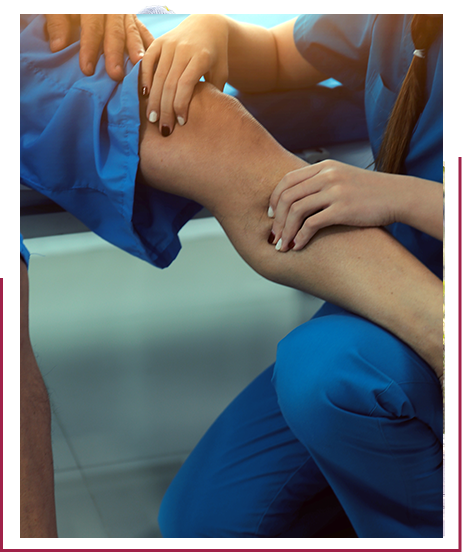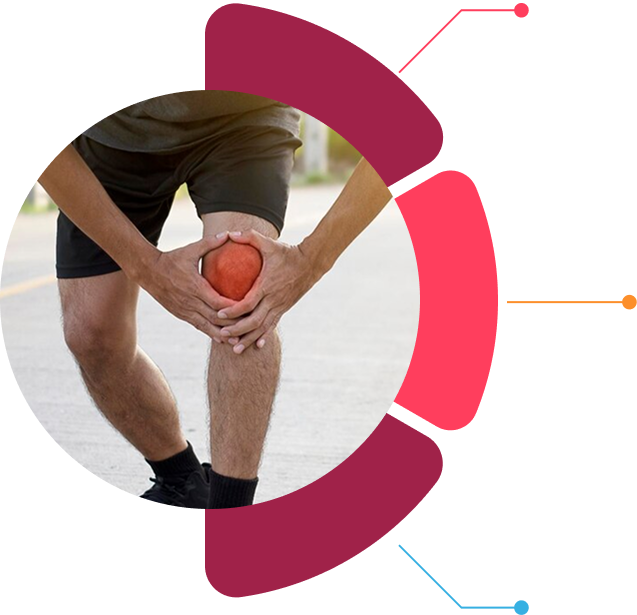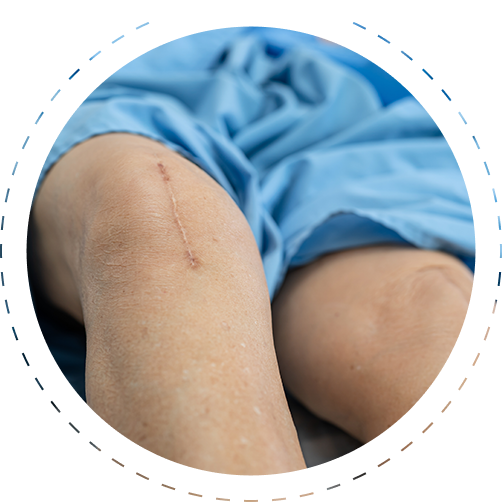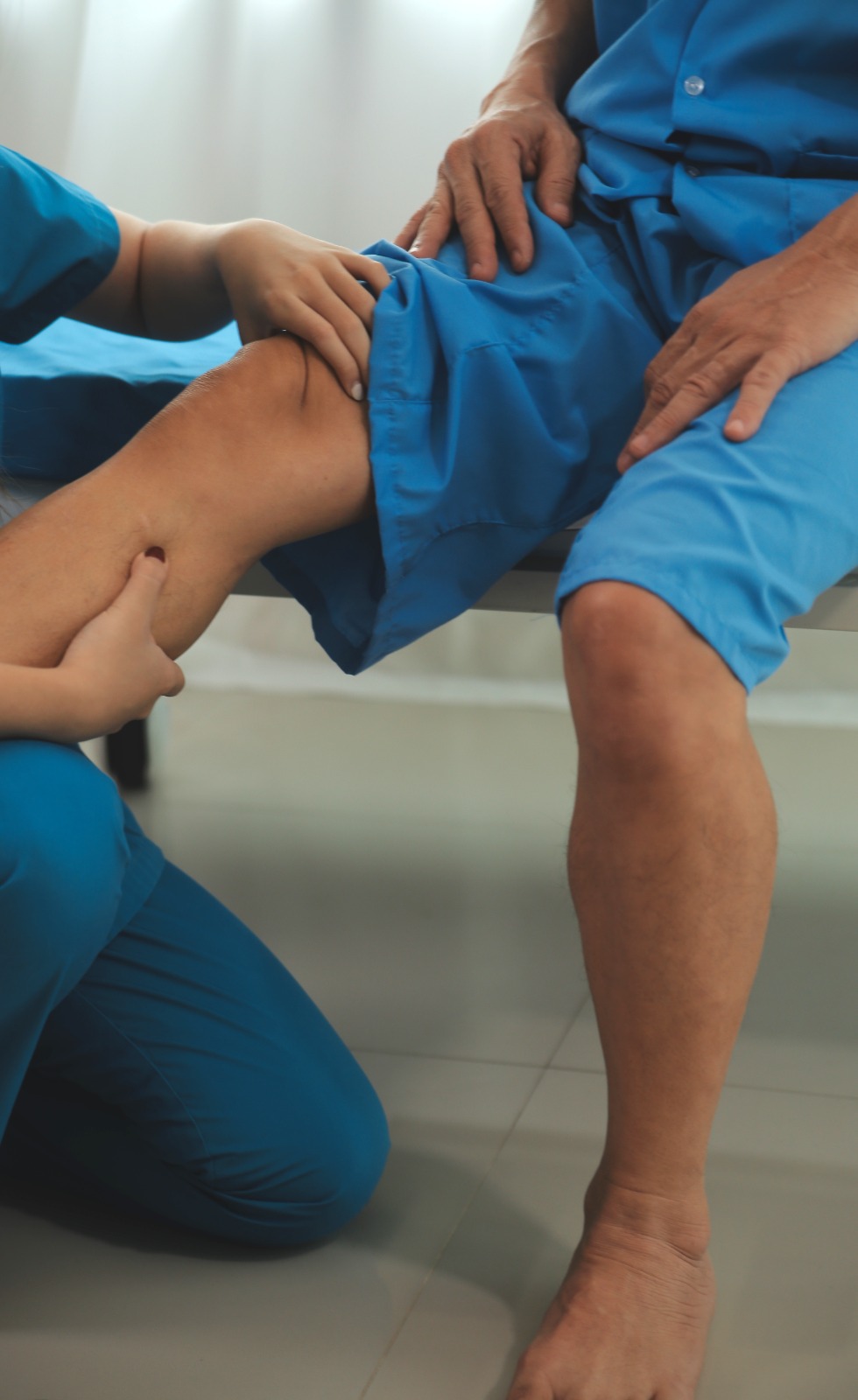Knee Replacement Surgery in Ahmedabad
Dr. Saurin Shah’s Expertise

Why Total Knee Replacement is important?
According to best knee replacement surgeon in Ahmedabad – Dr. Saurin Shah, If your knee damaged by arthritis or injury, it may be hard for you to perform simple activities, such as walking or climbing stairs. You may even felt pain while you are sitting or lying down.
Joint replacement surgery is a safe and effective procedure to relieve pain, correct leg deformity, and help you resume normal activities.
Dr. Saurin Shah (Knee replacement surgeon in Ahmedabad), total knee arthroplasty is a surgical procedure. It replaces the weight-bearing surfaces of the knee joint to relieve the pain and disability of osteoarthritis.

Total Knee Replacement in Ahmedabad – Advanced Solutions with USFDA-Approved Implants
Chronic knee pain from arthritis or injury can severely limit your movement making daily activities like walking or climbing stairs unbearable. Dr. Saurin Shah recommends total knee arthroplasty (TKA) as a safe, proven solution to relieve pain, correct deformities and restore function.
Total knee replacement is advised under circumstances where
-
Knee has bowed in/out because of arthritis
-
Severe immobility and dysfunction in routine activities (walking, bending, running, etc.
-
Persistent swelling, pain and/inflammation in knee even during rest hours.
-
Ineffectiveness of medication, treatment or therapy for swelling and/pain.

When is Knee Replacement Needed?
-
Severe knee pain & swelling (even at rest)
-
Bowed legs caused by advanced arthritis
-
Loss of mobility affecting daily life
-
Failed medications, injections, or physiotherapy

Causes of Knee pain
The most common cause of chronic knee pain and disability is arthritis. Although there are many types of arthritis, most knee pain caused by just three types: osteoarthritis, rheumatoid arthritis, and post-traumatic arthritis.

Osteoarthritis:
This is an age-related “wear and tear” type of arthritis. It usually occurs in people 50 years of age and older, but may occur in younger people, too. The cartilage that cushions the bones of the knee softens and wears away. The bones then rub against one another, causing knee pain and stiffness.
Rheumatoid arthritis:
This is a disease in which the synovial membrane that surrounds the joint becomes inflamed and thickened. This chronic inflammation can damage the cartilage and eventually cause cartilage loss, pain, and stiffness. Rheumatoid arthritis is the most common form of a group of disorders termed “inflammatory arthritis.”
Post-traumatic arthritis:
This can follow a serious knee injury. Fractures of the bones surrounding the knee or tears of the knee ligaments may damage the articular cartilage over time, causing knee pain and limiting knee function.
Leading Causes of Knee Pain
The most common cause of chronic knee pain and disability is arthritis. Although there are many types of arthritis, most knee pain caused by just three types: osteoarthritis, rheumatoid arthritis, and post-traumatic arthritis.

Osteoarthritis (Wear & Tear)
Most common in people over 50, where cartilage breakdown causes bone-on-bone friction.
Rheumatoid Arthritis (Autoimmune Disorder)
Causes inflammation that damages cartilage, leading to chronic stiffness and deformity.
Post-Traumatic Arthritis (After Injury)
Develops after fractures or ligament tears, leading to joint degeneration.
Total Knee Replacement Technique
- Shaping the distal femoral bone
- Preparing the proximal tibial bone
- Preparing the patella
- The femoral component Placement
- Placing the tibial components
- Placing the patellar component
- Closing the incision
The surgery includes the presentation of a joint from the front of the knee, it uproots The patella to the other side of the joint permitting introduction of the distal end of the femur and the proximal end of the tibia. It expels the ligaments and the front cruciate tendon; the back cruciate tendon may remove (in cruciate balancing out plan) however the tibial and fibular security tendons save.
It removes the cartilages and the anterior cruciate ligament; the posterior cruciate ligament may remove (in cruciate stabilizing design) but the tibial and fibular preserve collateral ligaments. Metal components then impacted onto the bone & fixed using polymethylmethacrylate (PMMA) cement.
It uses around ended implant for the femur, mimicking the natural shape of the bone. On the tibia, the component is flat, although it often has a stem which goes down inside the bone for further stability.
It then inserts a flattened or slightly dished high-density polyethylene surface onto the tibial component so it transfers the weight and metal to plastic not metal to metal. During the operation, any deformities correct, and the ligaments balanced so that the knee has a good range of movement and is stable.
Sometimes, the articular surface of the patella removed and replaced by a polyethylene button cemented to the posterior surface of the patella. In other cases, it replaces the patella unaltered.

Advanced Knee Replacement Techniques in Ahmedabad
Dr. Saurin Shah uses cutting-edge surgical methods with US FDA-approved implants for precision and durability. The surgical procedure includes:
- Reshaping the femur & tibia bones
- Removing damaged cartilage
- Implanting high-performance knee prosthetics
- Ensuring optimal alignment & stability
Premium US FDA-Approved Implant Brands Used:
These US FDA-cleared implants ensure:
- Longevity (20–30+ years)
- Enhanced movement (high-flexion designs)
- Reduced risk of wear & loosening

Types of implants
Implant Surgeon Dr. Saurin Shah (Knee replacement surgeon in Ahmedabad) is using implants from renowned brands like DePuy (J&J), Exactech (USA), Zimmer.
There are wide varieties of implants available for this surgery.
Broadly this can be…
- All Poly (AP) verity (made up of a metal femoral component & plastic tibial component),
- Metal Back (MB) Variety (Metal femur, metal tibial base plate, and a fixed plastic insert)
- High flexion verity (specially designed components, which can sustain more strain in deep flexion activities)
- Rotating Platform (RP) design (Metal femur, metal tibial base plate, and a plastic insert, in between, which rotates on a metal tibial base plate to mimic the natural rotation on femur over tibia).
Some cases may require additional implants like steam, screws, metal wedges, etc.
The Metal uses which is Titanium or Chromium-Cobalt. Plastic is Polyethylene.
Why Choose Dr. Saurin Shah?
- Expertise in Minimally Invasive TKR
- Personalized Implant Selection (cruciate-retaining, rotating platform, etc.)
- Faster Recovery & Pain Relief
- Trusted by Patients Across Gujarat
Results After Knee Replacement Surgery
Most patients of Dr. Saurin Shah who is best knee replacement surgeon in Ahmedabad, have below results after knee replacement surgery:
- Pain relief
- Improved mobility and a better quality of life
- most knee replacements expected to be last over 15 years
- you can resume most daily activities, such as shopping and light housekeeping within three to six weeks after surgery
- Driving is also possible at around three weeks if you can bend your knee far enough to sit in a car, if you have enough muscle control to operate the brakes and accelerator, and if you’re not still taking narcotic pain medications.
- you can engage in various low-impact activities, such as
- walking
- swimming
- golfing
- Playing Garba
- biking
- But avoid higher impact activities — such as jogging, skiing, tennis, and sports that involve contact or jumping. Talk to your doctor about your limitations.





